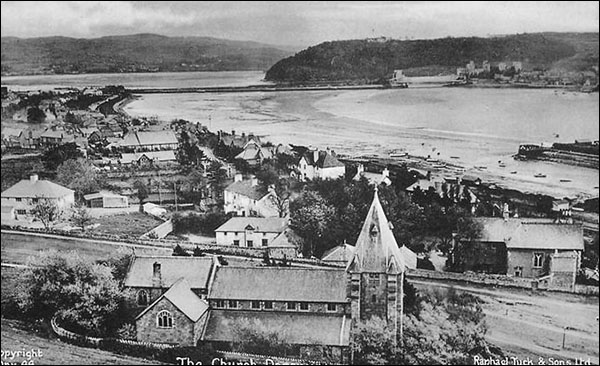All Saints Church, Deganwy
All Saints Church was built from 1897 to 1899 to replace an earlier mission church. The church was built on land given by Lord Mostyn and funded by his mother, Lady Henrietta Augusta Mostyn, in memory of her parents, the Earl and Countess of Abergavenny.
 The church was designed by architect John Douglas of Chester, whose other works include the prominent Eastgate Clock in Chester. The church was built by Messrs Samuel Parry of Llanrwst and Llandudno using a rare type of stone called Gloddaeth Purple Sandstone – see the footnotes for more about the stone. The church was consecrated on All Saints’ Day, 1 November 1899.
The church was designed by architect John Douglas of Chester, whose other works include the prominent Eastgate Clock in Chester. The church was built by Messrs Samuel Parry of Llanrwst and Llandudno using a rare type of stone called Gloddaeth Purple Sandstone – see the footnotes for more about the stone. The church was consecrated on All Saints’ Day, 1 November 1899.
The church includes a chancel, nave and north and south aisles. The west tower forms the base for the baptistery. The north chamber houses the organ and vestry. The reredos (decorative screen) on the east wall represents the Good Shepherd and is flanked by the Ten Commandments.
The organ was built for the opening of the church in 1899 by Alex Young and Sons of Manchester. The church bells were manufactured by Taylor of Loughborough and were on view at the Ecclesiastical Arts Exhibition in London during Church Congress Week 1899.
The church’s stained glass windows include a two-light window, by Henry Gustave Hiller, depicting the standing figures of St David and St Martin. The east window, depicting the Nativity, Crucifixion, Resurrection and Ascension, is a memorial to the Earl and Countess of Abergavenny.
Inside the church is a memorial to the men of Deganwy and the parish of Llanrhos who died in the First World War. This was designed to match the reredos by JH Hutchings, an art master and chorister at All Saints. A smaller tablet on the north wall is dedicated to the men of Deganwy who died in the Second World War. You can read details of those named on the memorials here.
With thanks to Pat Chapman, and to Ruth Siddall of the Welsh Stone Forum for the footnotes
Postcode: LL31 9DZ View Location Map
Parish website
Footnotes: About Gloddaeth Purple Sandstone
The church was the first new building to use this type of stone for 500 years. Previously it was used for window dressings at Conwy Castle and for various other medieval buildings, including Aberconwy House and Dolwyddelan Castle. One of the quarries where the stone outcrops was on the Bodysgallen Estate, which Lady Augusta Mostyn owned. She reopened the quarry for renovations to her home, Gloddaeth Hall. The Gloddaeth Purple Sandstone you can see at the church is a coarse, cross-bedded gritstone with dark red-brown iron-oxide nodules.

